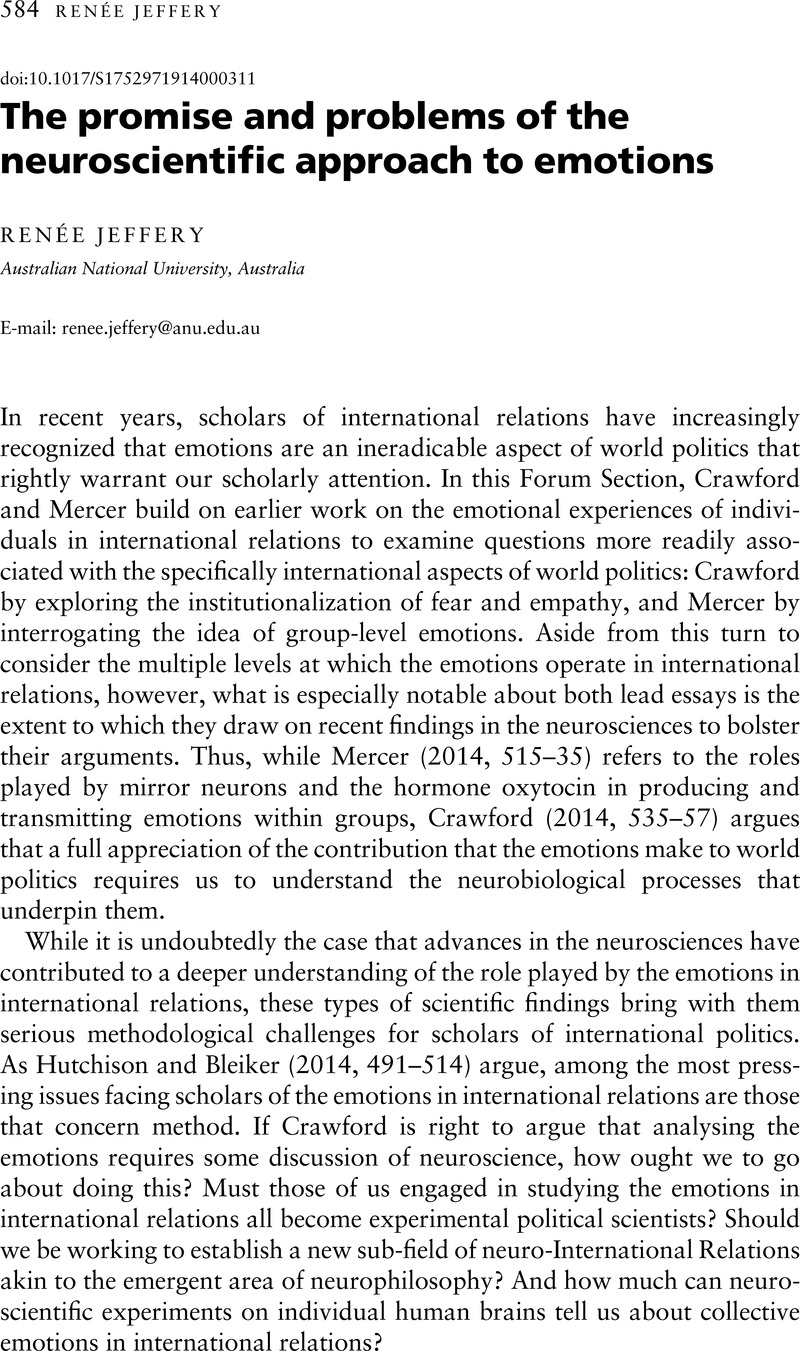Crossref Citations
This article has been cited by the following publications. This list is generated based on data provided by Crossref.
Branch, Jordan
2016.
How should states be shaped? Contiguity, compactness, and territorial rights.
International Theory,
Vol. 8,
Issue. 1,
p.
1.
2016.
Affective Communities in World Politics.
p.
1.
Ringmar, Erik
2016.
How the world stage makes its subjects: an embodied critique of constructivist IR theory.
Journal of International Relations and Development,
Vol. 19,
Issue. 1,
p.
101.
Duncombe, Constance
2016.
Cowardice: a brief history.
Global Discourse,
Vol. 6,
Issue. 1-2,
p.
258.
Clément, Maéva
and
Sangar, Eric
2018.
Researching Emotions in International Relations.
p.
1.
Bleiker, Roland
and
Hutchison, Emma
2018.
Researching Emotions in International Relations.
p.
325.
Norman, Ludvig
2018.
Theorizing the social foundations of exceptional security politics: Rights, emotions and community.
Cooperation and Conflict,
Vol. 53,
Issue. 1,
p.
84.
Åhäll, Linda
2018.
Affect as Methodology: Feminism and the Politics of Emotion1.
International Political Sociology,
Vol. 12,
Issue. 1,
p.
36.
Lynggaard, Kennet
2019.
Methodological Challenges in the Study of Emotions in Politics and How to Deal With Them.
Political Psychology,
Vol. 40,
Issue. 6,
p.
1201.
Hedström, Jenny
2019.
Confusion, Seduction, Failure: Emotions as Reflexive Knowledge in Conflict Settings.
International Studies Review,
Vol. 21,
Issue. 4,
p.
662.
Beattie, Amanda Russell
Eroukhmanoff, Clara
and
Head, Naomi
2019.
Introduction: Interrogating the ‘everyday’ politics of emotions in international relations.
Journal of International Political Theory,
Vol. 15,
Issue. 2,
p.
136.
Gammon, Earl
2020.
Affective neuroscience, emotional regulation, and international relations.
International Theory,
Vol. 12,
Issue. 2,
p.
189.
Magcamit, Michael
2021.
To feel is to believe: China, United States, and the emotional beliefs of Philippines’ Rodrigo Duterte.
Political Science,
Vol. 73,
Issue. 1,
p.
6.
Attard, Keith
and
Schembri Frendo, Clarisse
2022.
The Neuroscience of Emotions and the Role Emotions Play in Learning.
Malta Journal of Education,
Vol. 3,
Issue. 1,
p.
15.
Cornut, Jérémie
2022.
Emotional Practices and How We Can Trace Them: Diplomats, Emojis, and Multilateral Negotiations at the UNHRC.
International Studies Quarterly,
Vol. 66,
Issue. 3,
Suchkov, M. А.
2024.
Ideas and Methods of Cognitive Science in the Studies of International Relations and Foreign Policy.
Journal of International Analytics,
Vol. 15,
Issue. 2,
p.
146.
Travouillon, Katrin
Lemay-Hébert, Nicolas
and
Wallis, Joanne
2024.
An emotions agenda for peace: Connections beyond feelings, power beyond violence.
Cooperation and Conflict,
Vol. 59,
Issue. 2,
p.
135.
Goetze, Catherine
2024.
Symbolic stories of family in the language of peace.
Cooperation and Conflict,
Vol. 59,
Issue. 2,
p.
247.
Suchkov, M. A.
and
Baykov, A. A.
2024.
Ideas and Methods of Cognitive Science in the Studies of International Relations and Foreign Policy.
Journal of International Analytics,
Vol. 15,
Issue. 2,
p.
146.
Bell, Colleen
and
Wegner, Nicole
2025.
Feminist Foreign Policy as a Case of Governance Feminism: Neoliberalism, Militarism, and Women as “Agents of Change”.
International Studies Review,
Vol. 27,
Issue. 1,


